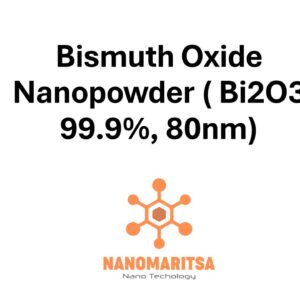Iron hydroxide nanopowder (Fe(OH)₃, 99.9%, 10 nm) is a highly specialized nanomaterial known for its unique chemical and physical properties. Its small particle size and high purity enhance its functionality in various applications, including environmental remediation, catalysis, energy storage, and biomedicine.
Composition and Structure
Fe(OH)₃ (Iron Hydroxide):
Iron hydroxide consists of iron ions in the +3 oxidation state coordinated with hydroxide ions (OH⁻). This compound often forms as a precursor to iron oxide materials. It is commonly found in nature as goethite or ferrihydrite and plays a key role in many environmental processes.
Purity (99.9%):
The high purity level ensures that the nanopowder is free from impurities, making it suitable for advanced applications where contamination can affect performance or results.
Particle Size (10 nm):
The 10 nm size gives the material a high surface area, which increases its reactivity and adsorption capacity, enabling effective interaction with contaminants and other substances.
Properties
- High Surface Area:
The 10 nm size provides a large surface area to volume ratio, enhancing the nanopowder’s ability to adsorb and interact with molecules, which is important for catalysis and environmental applications. - Hydrophilic Nature:
Fe(OH)₃ nanoparticles are hydrophilic, making them ideal for aqueous applications, particularly in water treatment and environmental remediation processes. - Chemical Stability:
The material is chemically stable, making it suitable for use in various environmental and industrial applications without significant degradation over time. - Biocompatibility:
Fe(OH)₃ is biocompatible, which makes it a safe option for medical and biological uses, especially when functionalized for specific purposes.
Applications
1. Environmental Applications:
Water Purification:
Fe(OH)₃ nanoparticles are effective in removing pollutants from water, including heavy metals, dyes, and organic contaminants, thanks to their large surface area and strong adsorption capacity.
Pollutant Removal:
The nanoparticles are used in environmental remediation processes, where they break down or adsorb harmful substances in both water and air, contributing to pollution control.
Soil Remediation:
Iron hydroxide nanoparticles can be applied to contaminated soils to immobilize toxic metals and help restore the soil to a safer, more usable condition.
2. Catalysis:
Redox Catalysis:
Fe(OH)₃ nanoparticles can catalyze redox reactions, making them useful in a variety of chemical processes, such as the reduction of pollutants and the synthesis of organic compounds.
Environmental Catalysis:
They are also used in catalytic processes to degrade pollutants, contributing to cleaner industrial and environmental practices.
3. Energy Applications:
Energy Storage:
Fe(OH)₃ is investigated for use in energy storage devices like batteries and supercapacitors, where it can improve the performance of electrodes and increase energy capacity.
Photocatalysis:
Iron hydroxide nanoparticles can be employed in photocatalytic processes, such as water splitting to produce hydrogen or the breakdown of pollutants under light exposure.
4. Biomedical Applications:
Drug Delivery Systems:
Functionalized Fe(OH)₃ nanoparticles are used to deliver drugs to targeted areas in the body, guided by an external magnetic field, for improved therapeutic effectiveness.
MRI Contrast Agents:
Fe(OH)₃ nanoparticles may be used as contrast agents in magnetic resonance imaging (MRI), enhancing the resolution and quality of the imaging process.
Safety and Handling
Health Considerations:
Due to their small size, Fe(OH)₃ nanoparticles may penetrate biological barriers. Appropriate precautions, such as wearing gloves, masks, and protective clothing, are recommended to minimize exposure and avoid inhalation or skin contact.
Environmental Impact:
Fe(OH)₃ is generally considered less toxic than other nanomaterials, but research is ongoing to fully understand its long-term effects on human health and the environment.
Summary
Iron hydroxide nanopowder (Fe(OH)₃, 99.9%, 10 nm) is a highly reactive and versatile material with significant potential in environmental, catalytic, energy, and biomedical applications. Its small particle size and high surface area make it particularly effective in pollutant removal, water treatment, and catalytic reactions. As research advances, this material is poised to contribute to sustainable solutions in environmental science, energy, and healthcare.
| Measurement (gr) | 100 grams, 500 grams, 1000 grams |
|---|
Related products
-
Single-Element Oxides Nanopowder
Bismuth Oxide Nanopowder ( Bi2O3, 99.9%, 80nm)
0 out of 5(0)SKU: MN09NP0211€96.00 This product has multiple variants. The options may be chosen on the product page -
Single-Element Oxides Nanopowder
Cuprous Oxide Nanopowder (Cu2O, high purity, 99+%, 18nm)
0 out of 5(0)SKU: MN09NP0222€368.00 This product has multiple variants. The options may be chosen on the product page -
Single-Element Oxides Nanopowder
Aluminum Oxide Nanopowder (Al2O3, Alpha, 99.9%, 135nm)
0 out of 5(0)SKU: MN09NP0202€64.00 This product has multiple variants. The options may be chosen on the product page -
Single-Element Oxides Nanopowder
Cerium Oxide Nanopowder ( CeO2, 99.9+%, 10-30nm)
0 out of 5(0)SKU: MN09NP0213€224.00 This product has multiple variants. The options may be chosen on the product page






